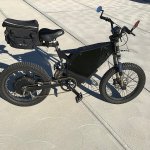DogDipstick said:Yes: understood: However, you negate something. Look at the average: Speed (25mph load)~ , and : Power ( reflecting the consumption): you will see they are both the similar league but the power average is quite higher with the thermal waste of 100A on tap at all times.. on a 35A hub motor. The system physically limits the power. ON the lower. So less consumption, even though with the ATF you would think the load is a little more from the drag. NO Load RPM went from 1.2A to 2A. Upon using the oil... On cold days it is noticeable, the increase in rolling drag. But... consumption lowered. I could zoom in on the throttle trace and we would see WHEN the CA3 was actually limiting the THout (on the lower ride).
These are identical rides.. ( route). And yes.. the actual discrepancy is noted that one, (( lower log, thermally limited, 100* soft and 150* hard,) and with rollback enacted) is compromised to a degree.... , even though the Aux amp variable is 100% on both logs.. the lower gets hot and limits power.. so no comparison.
Still, same average speed, time, route, distance and very similar peaks.. coincidences aside. Average temp is controlled in one, and not controlled in the other.. and I still got to the store in the same amount of time.
I didn't negate anything; in fact, I only gave a passing glance to the logs. Instead, based solely on the implausible conclusion (700W reduction), I concluded that the data --upon which that conclusion is based-- is therefore not comparable.
I appreciate this may be the best comparison data you have available, but in science, if you receive a prima facie implausible result, you have to explain the mechanism, or face the possibility that your data may not be correct.
We know reducing winding temperature reduces winding resistance, and therefore winding resistance loss.
Let's say the motor phase resistance is 0.2Ω at 20C; temperature coefficient of resistivity for copper is 0.0039/C; we'll use your 35A figure.
resistance final = resistance initial * [1 + temp coefficient(temp final – temp initial)]
resistance HOT = 0.2Ω * [1 + 0.0039/C(105-20)] = 0.2663Ω @ 105C
resistance OIL = 0.2Ω * [1 + 0.0039/C(69-20)] = 0.2382Ω @ 69C
1 - (0.2382Ω / 0.2663Ω) = 10.5% lower resistance -- GREAT!
winding resistance loss = A^2 * motor phase resistance
loss HOT = 35A^2 * 0.2663Ω = 326W
loss OIL = 35A^2 * 0.2382Ω = 292W
326W - 292W = 34W reduction -- still GREAT!
But an order of magnitude off from the 700W claimed reduction.
And since the math is easy at 100A, let's just say you rode around at 100A continuously
loss HOT = 100A^2 * 0.2663Ω = 2663W
loss OIL = 100A^2 * 0.2382Ω = 2382W
2663W - 2382W = 281W reduction -- still far less than half the 700W claimed. But shows how important resistance is at high current.
Also, this doesn't account for the 0.8A = ~60W oil drag


